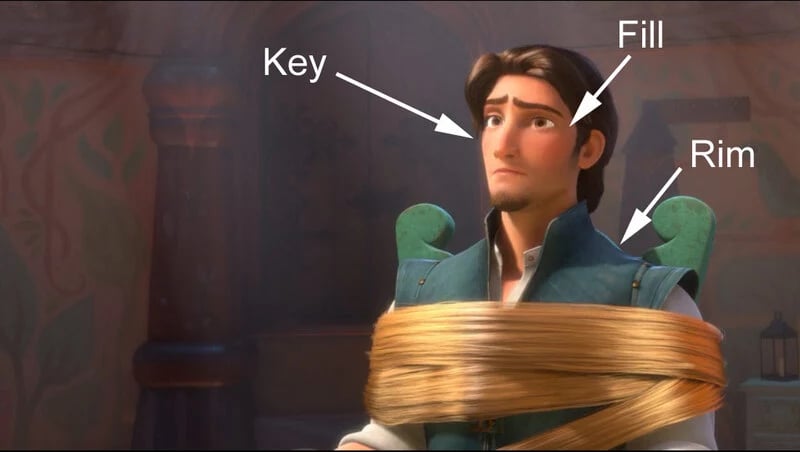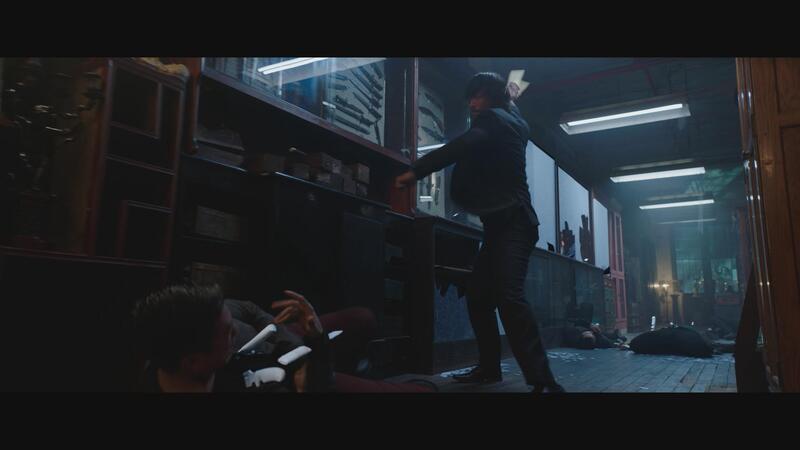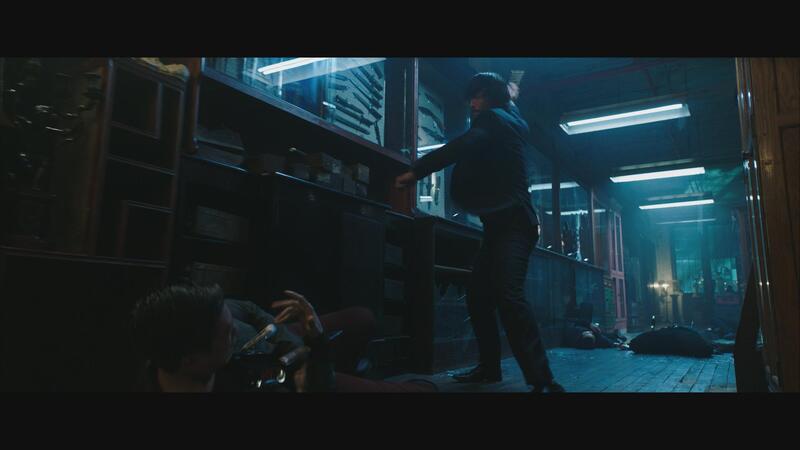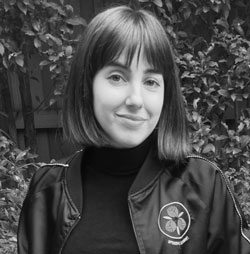3D lighting adds realism and depth to a scene while also enhancing the mood, tone, and ambiance of an unfolding story in film and games. This blog dives into the world of 3D lighting and shares some of the skills you need to become a 3D lighting artist.
What is 3D lighting, and what does a 3D lighting artist do?
3D lighting involves simulating the behavior of light in a real-world or fantasy situation, including shadows, reflections, highlights, and color, using specialized lighting software and rendering tools.
Combining technical and creative skills, lighting artists place virtual lights into a 3D scene and then adjust them in terms of intensity, direction, and hue to match a live-action plate or 3D environment. Lighting helps integrate various 3D elements (effects, props, characters, etc.) while also helping to set the mood or tone of a shot.
Lighting artists also need to consider external elements like the weather and time of day (e.g., the amount of sunlight, moonlight, cloud cover, etc.) along with artificial light sources already in their scene (e.g., a candle, police car lights, street lights, etc.).

Scene from Pixar's 3D animation Finding Nemo before and after it has been lit and rendered by a 3D lighting artist.
The skills of a 3D lighting artist can be applied in video games, 3D visualization, film and television, animations, and real-time 3D. On a smaller scale, 3D lighting also helps elevate the look of 3D models and create a more polished animation portfolio.
How does 3D lighting work?
3D lighting is based on the principles of cinematography and knowing how light behaves in real life. Armed with this knowledge and specialized software, 3D lighters create virtual light sources, which they then apply various kinds of reflection, refraction, dispersion, scattering, occlusion, and absorption techniques to.
To create these lighting effects, 3D lighters often use some of the following software:
- Autodesk Maya: Maya is an industry-standard 3D lighting and rendering software employed by some of the biggest VFX, game, and animation studios and allows the execution of large, complex shots. One of the benefits is that it's also used by other 3D artists, such as modelers and animators, making the sharing of files and assets more streamlined. Here’s a quick 3D lighting tutorial about how to use Maya to light your scene.
- SideFX Houdini: Houdini is a powerful tool that can be used as a layout and lighting-only application where all assets can be imported from other sources and rendered efficiently using built-in renderers Karma or Mantra (it can also be used with all the main 3rd party renderers). With the recent implementation of USD (Universal Scene Description) Houdini will likely be a really competitive choice for lighters over the other lighting and layout applications such as Clarisse and Katana. Here’s a tutorial on how to add lights to your scene using Houdini.
- Unreal Engine: This real-time engine is a staple of many game and virtual production studios. Using Unreal Engine and Lumen, you can add realistic lighting to a scene, including automatically changing real-time global illumination (such as sky rotation).
Video explaining how lighting (as well as surfacing) added realism and supported the emotional story arc of Netflix's 3D animated film Over the Moon.
4 examples of 3D lighting
There are many ways that light can shine on, around, and through objects, characters, and environments in the digital 3D world. Observing and studying different real-world lights and surfaces can help a 3D lighter create more realistic and effective lighting. Here are four types of lighting 3D lighting artists will commonly use:
1. Spotlighting
Similar to a real-life spotlight on a subject, spotlighting comes from a single source, shining in one direction in a cone shape that gets bigger the further the light travels. Think of the type of light that emits from a street light, a torch, or a desk lamp.
A 3D lighting artist can select an attenuation value to set the light beam's decay (or fall off). To create a sharper contrast, they would set the value somewhere between low to no falloff between where the light hits on the final surface and where the light fades off. For a more graduated, softer contrast a lighting artist would choose a higher falloff value.
 Example of spotlighting from a phone torch in the 3D animated film Zootopia (Image: Disney).
Example of spotlighting from a phone torch in the 3D animated film Zootopia (Image: Disney).
Spotlights are also used to create the three-point lighting effect that you commonly see in a photography studio which includes:
- Key light — the central light that illuminates the subject and helps create the overall mood of the scene.
- Fill light — a second light that mirrors the key light at a lower intensity to help soften the shadows and bring out details. (Fill light doesn't have to be a physical light, it can be anything that bounces light back, such as a wall or reflector.)
- Backlight — a third light shone from behind the subject that helps to highlight the subject’s edges (also known as a rim light) and gives them a better sense of depth.

Three-point lighting in action in Disney's Tangled. (Annotations by Edu Martin from their blog 'Lighting Pixels')
2. Point lighting
Point lights (sometimes called omni lights) are similar to spotlights, but emit light in all directions from a small, single point — like the light you get from candles, fairy lights, or a firefly. In addition to setting the attenuation values, 3D lighting artists can customize the brightness, color, size, and shape.
 Christmas lights inThe Smeds and Smoos are an example of point lighting (Image: Magic Light Pictures).
Christmas lights inThe Smeds and Smoos are an example of point lighting (Image: Magic Light Pictures).
3. Ambient lighting
Unlike a spotlight or point light, ambient light has no single source. In photography, it's the preexisting natural or artificial light already existing at the location they are shooting (e.g., sun/moonlight, overhead lights in a building, etc.).
3D lighting artists can only control the color and brightness of this type of lighting. Ambient lighting is designed to support your more direct lights.

When lighting the CG knives and glass (see sections in gray) in John Wick 3, 3D lighters at Method Studios needed to consider the ambient lighting from the preexisting ceiling lights.

The final 3D render of CG knives and glass with 3D lighting.
4. High-Dynamic-Range Imaging lighting (HDRI)
In real-life photography, a High-Dynamic-Range Imaging (HDRI) photograph captures more detail than a standard photo, allowing the photographer to play with the image's lighting in their editing software.
In 3D lighting, a lighting artist works with a 360-degree HDRI photograph of a real-world environment or set to help replicate its lighting conditions. This method often produces a final scene that more accurately mimics the conditions captured on camera.

While this can provide very realistic light results, a lighting artist has less flexibility over adjusting the light, aside from rotating the subject in relation to the light source or adjusting the brightness.
What skills does a 3D Lighting Artist need?
To become a 3D lighting artist, you should have good technical skills in lighting and a sound understanding of the principles of cinematography and how light reacts in different environments. (To see more required skills, head to the lighting artist career pathway page.)
A lighter's day-to-day tasks may include the following:
- Rendering shots (either digitally integrated VFX or full CG), including non-lighting passes as required by other departments.
- Compiling upstream elements such as environments, animation, and effects and ensuring they look correct when rendered.
- Creating or applying light rigs based on concept art or on set reference.
- Adjusting lighting brightness, tone, hue, and shadowing for each shot according to a brief.
How to become a 3D Lighting Artist
Becoming a 3D lighting artist takes dedication and practice. Start by looking at how your favorite films and games are lit, what techniques were used and why, and try to emulate them using relevant software.
If you are after more support on your journey to becoming a lighting artist, consider taking a course that is led by industry professionals. CG Spectrum, a proud Unreal Engine Academic Partner and Authorized Training Center, has courses that are taught by film, game, and virtual production experts and will provide you with foundational lighting knowledge. These include:
- Real-time 3D Foundations: Learn world building, lighting, and camera skills, using them to tell compelling stories and create film-quality environments. CGS graduate, Marc, took this course and is now working as a Cinematic Lighting Artist for Guerrilla Games!
- Real-time 3D Specialization: Gain advanced real-time 3D skills. Learn digital storytelling and hone your world-building, lighting, and camera skills to create film-quality cinematics. Graduate with a polished portfolio and sought-after job skills.
- 3D Visualization Foundations: Learn to translate ideas into the digital 3D space, establishing accurate representations of what buildings, sets, and landscapes will look like before they're even built! You'll also learn texturing, shading, lighting, and rendering.
Check out our virtual production student showreel to see the type of stunning scenes you could be adding to your portfolio!
Learn how to light incredible 3D scenes at CG Spectrum
Our real-time 3D courses and 3D visualization courses will teach you lighting essentials in industry standard software such as Unreal Engine and V-Ray and help you bring impressive 3D scenes to life! Your experienced mentors — real-time 3D artists, 3D visualization artists, cinematographers, and virtual production experts — will be there to guide and inspire you. Begin a bright future as a 3D lighting artist with CG Spectrum!

Related Links




